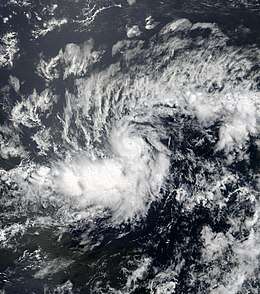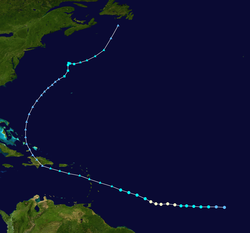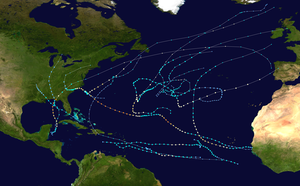Hurricane Beryl
Hurricane Beryl was the second-earliest Atlantic hurricane to form in the main development region (MDR) on record, the first to form in the MDR in July since Bertha in 2008, and the first July Atlantic hurricane since Arthur in 2014. The second named storm and first hurricane of the 2018 Atlantic hurricane season, Beryl formed from a vigorous tropical wave that moved off the west coast of Africa on July 2. The wave quickly organized into a tropical depression over the central Atlantic by July 4. Rapid intensification took place and it quickly became a tropical storm at 18:30 UTC that day. Just less than 15 hours later, Beryl strengthened into the first hurricane of the season, reaching its peak intensity on July 6. Increasingly unfavorable conditions caused a rapid deterioration of the cyclone shortly after peak, with Beryl falling to tropical storm status on the next day as it began to accelerate towards the Caribbean. Late on July 8, it degenerated into a tropical wave shortly before reaching the Lesser Antilles. The remnants were monitored for several days, although they failed to organize significantly until July 14, when it regenerated into a subtropical storm six days after its initial dissipation. However, the newly-reformed storm quickly lost convection, and it degenerated into a remnant low early on July 16, while over the Gulf Stream.
| Category 1 hurricane (SSHWS/NWS) | |
 Hurricane Beryl near peak intensity well to the east of the Lesser Antilles on July 6 | |
| Formed | July 4, 2018 |
|---|---|
| Dissipated | July 17, 2018 |
| (Remnant low after July 15) | |
| Highest winds | 1-minute sustained: 80 mph (130 km/h) |
| Lowest pressure | 991 mbar (hPa); 29.26 inHg |
| Fatalities | None |
| Damage | Minimal |
| Areas affected | Lesser Antilles, Puerto Rico, Hispanola, Eastern Cuba, The Bahamas, Bermuda, Atlantic Canada |
| Part of the 2018 Atlantic hurricane season | |
Beryl prompted multiple islands in the Lesser Antilles to issue warnings and watches, including a hurricane watch as it was initially expected to pass through the islands of Dominica and Guadeloupe as a hurricane. The storm weakened faster than expected and Beryl dissipated before it reached the islands, though effects were still felt across the eastern Caribbean. Several areas in the region were recovering from the catastrophic impacts from Hurricanes Irma and Maria during the previous season. Beryl's remnants caused flash flooding and landslides across the island of Puerto Rico and caused several schools to close; approximately 47,000 lost power on the island.
Meteorological history

Late on July 3, the NHC began tracking a vigorous tropical wave over the eastern tropical Atlantic for tropical cyclone development. The wave quickly organized as it moved westward, and at 15:00 UTC on July 5, it organized into a tropical depression while over the central tropical Atlantic Ocean.[1] The tiny system continued to quickly consolidate, with a mid-level eye becoming apparent. At 18:30 UTC, the depression strengthened into Tropical Storm Beryl while located at 10.3°N 42.3°W;[2] this was farther southeast than any other Atlantic cyclone on record so early in the calendar year.[3] Due to its very small size, it was prone to very quick changes in intensity. Indeed, overnight the cyclone underwent a period of rapid intensification as a 5 nmi (9.3 km) pinhole eye became visible and became a hurricane at 09:00 UTC July 6 – the second earliest in the tropical Atlantic on record, behind the 1933 Trinidad hurricane,[4][5] and the easternmost pre-August Atlantic hurricane on record to have formed from a tropical wave.[6]
Throughout the day the strengthening leveled off, and the eye later disappeared from satellite view, though Beryl maintained its intensity. By early on July 7, however, dry air began to infiltrate the core of the hurricane, causing its center to become exposed, and Beryl soon weakened back to a tropical storm.[7] This trend of rapid weakening continued as wind shear increased upon the system. Beryl's structure continued to decay as the storm accelerated west-northwestward, and by late on July 8, Beryl had degenerated into an open trough while located just 60 miles northeast of Martinique. The NHC opted to continue advisories, however, as it was impacting Dominica, discontinuing them afterwards.[8]
The remnants of Beryl, while being monitored by the NHC for potential redevelopment,[9] continued moving westward into the eastern Caribbean, eventually slowing and moving ashore in the Dominican Republic with gale-force winds.[10] Strong upper-level winds prevented any redevelopment of the remnants of Beryl for several days as it moved across the island and as it passed through the Bahamas into the Western Atlantic. By July 13, however, conditions became slightly more favorable for redevelopment, and the remnants of Beryl spawned a new circulation near the associated thunderstorms, though the remnants remained too disorganized for redevelopment.[11] The circulation became well-defined early on July 14, and due to influence from a baroclinic trough, thunderstorms developed and persisted near the storm's center, with gale-force winds detected east of the center; after continued reorganization, Beryl was re-designated as a subtropical storm at 17:00 UTC that day, while located well off the East Coast of the United States.[12] However, the rejuvenated storm soon began to weaken as nearby dry air intruded and weakened showers and thunderstorms associated with the storm, and impinging northwesterly shear further served to remove thunderstorm activity. By July 15, Beryl consisted mostly of a low to mid-level swirl of shallow clouds continuing on a northeastward course.[13] After lacking thunderstorm activity near the center for twelve hours, Beryl degenerated into a remnant low at 03:00 UTC on July 16.[14] Beryl's remnant low was subsequently absorbed into another extratropical storm over Newfoundland on the next day.
Preparations and impact
Lesser Antilles
.png)
On July 6, the Government of France issued a tropical storm watch for its overseas collective Saint Barthélemy. On July 7, the Government of France issued a tropical storm watch for Guadeloupe and its overseas collective Saint Martin in the Leeward Islands.[15] In preparation for the hurricane's arrival, the Government of Barbados issued a hurricane watch for Dominica in the Windward Islands and a tropical storm watch for Barbados in the Lesser Antilles on July 6. At the same time, the Government of St. Lucia issued a tropical storm watch for St. Lucia. Earlier, France had issued a tropical storm watch for Martinique, also in the Windward Islands. The next day, the Government of Barbados replaced the hurricane watch with a tropical storm warning as Beryl weakened before making landfall.[16]
Heavy rains and strong winds impacted Guadeloupe as the remnants of Beryl moved through the Lesser Antilles. Rainfall peaked at 7.8 in (199 mm) in Saint-Claude; wind gusts averaged 50 to 56 mph (80 to 90 km/h) island-wide with a peak of 62 mph (99 km/h) in Le Moule. The resulting damage was limited, with some trees and power lines downed and localized flooding from runoff.[17]
Puerto Rico
On July 6, the Governor of Puerto Rico, Ricardo Rosselló, issued a state of emergency for the island, amid concerns that enhanced rainfall from Beryl or its remnants could lead to flash floods and mudslides, damaging infrastructure that was still recovering from Hurricanes Irma and Maria from the previous season.[18] In the wake of July 10, approximately 24,000 Puerto Ricans lost power on the island as a result of gusty winds and flooding from Beryl's remnants.[19] The enhanced rainfall also triggered flash flooding that closed several roadways and downed several trees. A landslide was reported in the town of Naranjito, although there were no reports of fatalities or injuries.[20]
Dominican Republic
Heavy rainfall caused by the remnants of Beryl flooded hundreds of homes in the Dominican Republic and left 130,000 people and the capital city of Santo Domingo without power. In San Cristóbal Province, 700 homes and a recently opened hospital were flooded, and strong winds and heavy rains caused the walls of two schools to collapse. Countrywide, the floods left 8,000 people homeless and thousands more without clean drinking water, as the storm had knocked 75 aqueducts out of service. At the height of the storm, 19 communities were isolated from the surrounding areas. The floods damaged 1,586 homes and destroyed four.[21]
See also
| Wikimedia Commons has media related to Hurricane Beryl (2018). |
- Other tropical cyclones named Beryl
- Tropical Storm Anna (1969) – Storm with a similar track that reintensified into a tropical storm in roughly the same area.
- Hurricane Gertrude (1974) – Another rapidly-developing Category 1 hurricane.
- Hurricane Joyce (2000) – Low-latitude Category 1 hurricane that threatened similar areas.
- Hurricane Danny (2015) – Another small, rapidly-developing tropical cyclone.
References
- Stacy R. Stewart (July 5, 2018). "Tropical Depression Two Discussion Number 1". National Hurricane Center. Retrieved July 5, 2018.
- Michael Brennan; Robbie Berg (July 5, 2018). Tropical Storm Beryl Tropical Cyclone Update (Report). Miami, Florida: National Hurricane Center. Retrieved July 5, 2018.
- Philip Klotzbach [@philklotzbach] (5 July 2018). "Tropical Storm Beryl has formed in the tropical Atlantic - the furthest southeast a named storm has formed this early in the hurricane season on record" (Tweet). Retrieved 13 July 2018 – via Twitter.
- Daniel P. Brown (July 6, 2018). Hurricane Beryl Discussion Number 4 (Report). Miami, Florida: National Hurricane Center. Retrieved July 6, 2018.
- Marshall Shepherd (July 6, 2018). "Beryl Is The First Atlantic Hurricane Of 2018 - But Keep An Eye On The Carolinas Too". Forbes. Retrieved July 6, 2018.
- Brian McNoldy [@BMcNoldy] (6 July 2018). "Of the 89 pre-August hurricanes on record, Beryl is the easternmost among those that formed from African waves... by a HUGE margin! 1 further east was Dorothy on July 24, and 2 further east were in January (all 3 moving north)" (Tweet). Retrieved 13 July 2018 – via Twitter.
- Robbie Berg (July 7, 2018). "Tropical Storm Beryl Advisory Number 9". National Hurricane Center. Retrieved July 7, 2018.
- Stacy R. Stewart (July 8, 2018). "Remnants of Beryl Advisory Number 14". National Hurricane Center. Retrieved July 8, 2018.
- "5-Day Tropical Weather Outlook". National Hurricane Center. July 9, 2018. Retrieved July 14, 2018.
- "5-Day Tropical Weather Outlook". National Hurricane Center. July 10, 2018. Retrieved July 14, 2018.
- "5-Day Tropical Weather Outlook". National Hurricane Center. July 13, 2018. Retrieved July 14, 2018.
- Jack Beven (July 14, 2018). "Subtropical Storm Beryl Discussion Number 16". National Hurricane Center. Retrieved August 4, 2018.
- Jack Beven (July 15, 2018). "Subtropical Storm Beryl Discussion Number 21". National Hurricane Center. Retrieved July 16, 2018.
- Daniel P. Brown (July 16, 2018). Post-Tropical Cyclone Beryl Discussion Number 22 (Report). Miami, Florida: National Hurricane Center. Retrieved July 16, 2018.
- Robbie Berg (July 6, 2018). "Hurricane Beryl Advisory Number 6". National Hurricane Center. Retrieved July 6, 2018.
- Berg. "Tropical Storm Beryl Advisory Number 9". National Hurricane Center. NOAA. Retrieved 9 July 2018.
- "L'onde tropicale Beryl balaie la Guadeloupe le 9 juillet avec de fortes pluies orageuses" (in French). Keraunos. July 9, 2018. Retrieved July 14, 2018.
- Sosnowski, Alex (July 7, 2018). "Hurricane Beryl to raise risk of flooding in Caribbean; State of emergency declared in Puerto Rico". AccuWeather. Retrieved July 7, 2018.
- "Beryl's Remnants Trigger Flooding in Puerto Rico, 24,000 Lose Power". The Weather Channel. July 9, 2018.
- "Beryl Knocks Out Power, Floods Homes on Islands Still Recovering From Last Year's Hurricanes - The Weather Channel". Retrieved 24 July 2018.
- "Más de 8,000 dominicanos, desplazados por las lluvias causadas por Beryl". Panamá América (in Spanish). July 10, 2018. Retrieved July 14, 2018.
